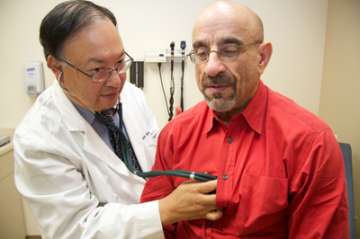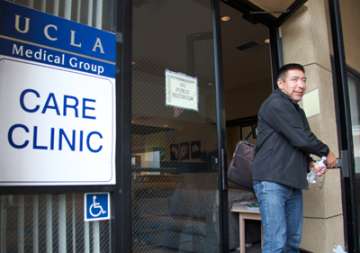About Us
About Us
The UCLA Center for Clinical AIDS Research and Education (CARE) provides state-of-the-art medical care and conducts clinical trials for people living with HIV and AIDS. Our highly trained, nationally recognized physicians are leaders in the field of HIV Medicine, Infectious Diseases, Oncology and other areas relevant to the health of our patients. The CARE Center’s research team is committed to conducting a broad program of ethical and high quality clinical, behavioral and prevention research to promote the health of people living with or at risk for acquiring HIV and other infectious diseases.
The CARE Center is the UCLA base for several national and international HIV research networks as well as a site for pharmaceutical and biotechnology industry-sponsored trials and novel, small-scale, investigator-initiated trials.
Mission
The mission of the UCLA CARE Center is three-fold.
CARE: provide exceptional and state-of-the-art care to patients with HIV and AIDS.
RESEARCH: facilitate a broad program of clinical, behavioral and prevention research in HIV; and develop and clinically evaluate new treatment and novel therapeutic approaches for HIV, HIV-related diseases and co-infections, and complications of therapy to improve patients’ quality of life.
EDUCATION: educate HIV positive patients and people at risk for HIV-infection throughout Los Angeles about treatment and prevention, and engage with community leaders and partner organizations in the greater discourse about HIV and HIV-related diseases and co-infections.
Goals
- Maintain a multidisciplinary outpatient clinic dedicated to providing state-of-the-art care to patients with HIV and related diseases.
- Establish and promote a world-renowned clinical research center that conducts clinical investigations and clinical trials in all areas of HIV therapeutic research and co-infections.
- Provide education and training activities in HIV for the UCLA community, treatment providers, patients, AIDS research organization and the general community about HIV, its treatment, and research.
Our History
By Kathryn Rogers
When Tom Gillman was first referred to UCLA for treatment of what would come to be recognized as AIDS-related Kaposi’s Sarcoma, he was seen by a lone oncology researcher and his nurse. Now, 28 years and multiple office relocations later, Tom is still receiving his HIV primary care from the same UCLA doctor. But more importantly, he is still alive to tell the story, determined that “something else will kill him besides HIV.”

Ronald Mitsuyasu, M.D., founded UCLA’s clinical program in HIV in 1981 out of necessity. When AIDS was first described at UCLA, Dr. Mitsuyasu, who was working as an oncologist alongside Jerome Groopman, M.D., started seeing patients come in with Kaposi’s Sarcoma. Dr. Mitsuyasu quickly recognized that these news AIDS patients required specialized care, so withlimited supervision and minimal institututional support, he began a research program on HIV/AIDS at UCLA in the hope of finding ways to help these patients. He managed to find continuous funding from a series of independent grants, and hired Susie McCarthy as a research nurse in 1983. Together, they set out to face the challenges of HIV head on, dedicated to working purely because patients needed care, in spite of the fears surrounding HIV/AIDS.
At the time, so little was known about HIV/AIDS that even with the most cutting edge research, the process of understanding the disease was slow and patients were dying. And then came the social stigmas. Although McCarthy was never personally afraid of working with HIV positive patients, her family was affected by her career choice. McCarthy’s daughter came home from school in tears one day because no one wanted to play with her because they thought she would get HIV since her mom was working with HIV patients. The lack of education about HIV transmission made for an especially arduous process of educating patients, their family members, other providers and the community at large. McCarthy recounts the secrecy surrounding HIV at the time:
“One day a fellow [patient] came in and brought his mother. He wanted us to explain to the mother about HIV. It was really very emotional. The mother had no idea that her son was gay, and that he had HIV. She was very appreciative of us talking to her. But just this lack of knowledge. That was really something to see, the interaction with the son and the mother and us talking to her. They didn’t talk about it. It was private.”
In spite of all the difficulties, Dr. Mitusuyasu and McCarthy were making a difference. Gillman remembers his first visit to Dr. Mitsuyasu’s office as being “the most welcoming, wonderful environment.” More importantly, the experimental treatment for his KS lesions worked. Gillman describes the experience with marvel:
“We were setting the protocol then, because they didn’t know. I asked him [Dr. Mitsuyasu], “what’s your experience?” And he didn’t have any. I had a number of lesions. The first regimen was six weeks and I gave myself a shottwice a day, massive amounts of interferon. And six weeks later, I went it to have an anascopy, and they were gone. This was astounding, and not observed in anyone up to that point, as I understand it. I did another six to eight weeks of treatment, same intensity, and they were gone. They’re still gone.”

Over the next few decades, UCLA’s HIV research program expanded to address the continually changing needs of patients. Dr. Mitusuyasu’s clinic moved from the oncology department offices to the basement of UCLA’s old hospital, where he started their own HIV-dedicated patient research program. And even though Gillman describes the windowless space as a “dungeon,” it was a relief to many patients to be seen in a private space where they wouldn’t be seen (and potentially stigmatized) by other non-HIV patients. In 1990, the UCLA Clinical AIDS Research and Education (CARE) Center got its official name with the development of UCLA’s unique department of infectious diseases, separate from oncology. The next move was to a more spacious office with a lobby and multiple exam rooms to accommodate more patients, including women and children. Gillman recounts being greeted here with a joke to help lighten the difficulty of the situation by Mike Marcial, the CARE Clinic’s Management Services Officer, who has worked at the CARE Center for 14 years, or as Gillman describes it, “forever.”
Twenty years later, the UCLA CARE Center has come a long way. What started as a 2-person operation in the wings of oncology under the direction of Dr. Mitsuyasu has grown into a thriving off-site clinic that sees 900 patients annually and is home to specialists in HIV treatment, prevention, co-morbidities, oncology, and long-term complications. The CARE Center has been housed at its current off-campus location at Pico and Roxbury since November 2005. The private clinic includes a spacious waiting room, six examination rooms and a procedure room, all dedicated patients seen by nine expert infectious disease providers supported by more than 25 research staff. From dungeons and shared offices to a dedicated clinic site, community outreach and global partnerships, even with all the growth, the UCLA CARE Center still maintains its core values of world class research and patient-centered care.
Photographs by Boza Ivanovic
Top Right: Dr. Ronald Mitsuyasu with patient Tom Gillman
Bottom Left: Patient Octavio Vallejo leaving the CARE Clinic at 1399 S. Roxbury Dr.